Reservoirs: How to manage your large raised reservoir
How to keep your reservoir operating safely. For reservoir owners, operators and those maintaining or operating large raised reservoirs in England.
Applies to England
Introduction
Dams and reservoirs are an important part of our national infrastructure.
If we do not manage them properly, they could cause:
- serious flooding
- major damage
- loss of life
They need monitoring and maintaining to keep them as safe as possible. The Environment Agency want to work with reservoir owners and operators (known as undertakers) to reduce the risk of dams failing.
We have produced this guide to help anyone who manages and operates reservoirs.
It contains advice on:
- the roles involved in managing reservoirs
- your role as an undertaker
- common problems
- how to spot them
- how to reduce the risk of these happening
This guide is not a substitute for professional advice. If in doubt, you must consult a qualified civil engineer.
Health and safety
Reservoirs can be dangerous places. You should always consider your health and safety when visiting your reservoir.
Take these steps to reduce the risks:
- wear appropriate clothing and footwear for the site
- take extra care not to slip on wet sloping surfaces such as the upstream (where water goes into the reservoir) and downstream (where water leaves the reservoir) faces of the dam
- wash your hands after touching reservoir water or wet vegetation – this prevents leptospirosis, Weil’s disease and other waterborne diseases
- wear gloves and use appropriate tools – for example, spindle extensions, lever bars and other specialist equipment are available for operating valves
- do not enter confined spaces such as manhole chambers or tunnels unless you are trained – specialist confined spaces safety training is available
- if visiting a remote reservoir, let people know where you are and when you expect to return
- take a telephone in case of emergency and check your signal on arrival
Legislation
Overview
The Reservoirs Act 1975 provides the legal framework for ensuring reservoir safety. Reservoir safety means the prevention of flooding from an uncontrolled escape of water (failure). The safe operation and management of reservoirs reduces the risk of dam or reservoir failure. The act covers any large raised reservoir (LRR). This is one where the volume of water held above the surrounding land is 25,000 cubic metres or more. That is approximately 10 Olympic swimming pools.
LRRs are spilt into ‘high risk’ and ‘not high risk’:
High risk reservoirs are those where an uncontrolled release of water from the reservoir could endanger human life. It does not mean that these reservoirs are at high risk of failure.
High risk LRRs must fulfil all the requirements of the act. Not high risk reservoirs must also fulfil specific requirements. Undertakers should be aware that under common law, they may be held responsible for any damage or injury caused by a failure. If an undertaker fails to ensure reservoir safety, they could also face criminal prosecution.
Employers also have a duty for the safety of others under current health and safety legislation.
Roles
Environment Agency
The Environment Agency is the enforcement authority for England. We follow the Regulator’s Code and are responsible for comprehensive regulation and enforcement of the act.
We are responsible for:
- maintaining a register of reservoirs and making this available to the public
- reporting to Defra
- making sure that undertakers have their high risk reservoirs regularly inspected by inspecting engineers
- making sure that undertakers appoint a supervising engineer for their high risk reservoirs
- making sure that undertakers appoint construction engineers to design and build their reservoirs
- making sure that undertakers carry out maintenance and necessary repairs to high risk reservoirs - an inspecting engineer will have said what is required at each reservoir
- making sure undertakers report on any incidents
- making sure that undertakers prepare on-site emergency flood plans for their reservoirs
- sharing the lessons learnt from incidents with the industry
- enforcing the act by working with undertakers to make sure they comply and if needed, warning and prosecuting those that do not
- commissioning engineering services and repairs if undertakers fail to comply - we then recharge our costs to the undertaker
- acting in an emergency if the undertaker is not available or incapable - we may recharge our costs to the undertaker
We are happy to advise undertakers and engineers on how to manage compliance. You can email us if you have any questions or would like to discuss any concerns relating to your reservoir.
Undertakers
Undertakers are operators or owners of a reservoir. They have ultimate responsibility for its safety.
They can include:
- water companies
- navigation authorities
- the Environment Agency
- the Ministry of Defence
- private landowners
- businesses, including commercial enterprises and farms
- other reservoir users such as sailing and fishing clubs
Even if a reservoir is not being used, responsibility rests with the owner. Section 4 of this guide gives an overview of the responsibilities an undertaker has.
All panel engineers
Panel engineers are a group of specialist civil engineers known as qualified civil engineers (QCEs). The Secretary of State appoints them. They are specifically experienced in, and are qualified for, reservoir safety.
Panel engineers may be:
- construction engineers
- inspecting engineers
- supervising engineers
The act requires them to oversee the safe construction, operation and maintenance of reservoirs.
The undertaker must appoint a construction engineer when:
- building a new reservoir
- existing reservoirs are repaired or changed
Construction engineer
The role of a construction engineer is to supervise the design and construction of a new reservoir. They are also required when modifying an existing reservoir. A construction engineer will be on the All Reservoirs Panel.
Inspecting engineer
Inspecting engineers must inspect high risk reservoirs at least every 10 years or more frequently if needed.
The role of an inspecting engineer is to:
- inspect a reservoir
- report their findings
- make recommendations to improve safety - these could be measures in the interest of safety, or maintenance measures
In their role as a QCE, they supervise and certify that the measures have been acted upon. Inspecting engineers are members of the All Reservoirs Panel.
Supervising engineer
The role of a supervising engineer is to:
- supervise the operation and maintenance of a reservoir at all times
- prepare a written statement (a section 12 statement) at least every 12 months that summarises the activities carried out to fulfil the inspecting engineer’s recommendations - it should also highlight if they are not doing this
- help the undertaker prepare incident reports and flood plans
- certify on-site flood plans
You can see a list of supervising engineers on the contact details of engineers on the supervising engineer panel website.
Undertaker requirements
Main responsibilities of an undertaker
As an undertaker, you must do certain activities to make sure your reservoir stays compliant with the act. These activities depend on the risk designation the Environment Agency has given your reservoir.
You will receive a risk designation from the Environment Agency after your reservoir construction is finished and certified.
We follow this process:
- the Environment Agency gives provisional risk designation - high risk or not high risk
- there is time for undertaker representation, which gives you the chance to provide further evidence if you disagree with the provisional designation
- the Environment Agency gives final designation
- there is time for appeal if your reservoir is designated as high risk
- the designation takes effect
You can email us if you have any questions about the designation of your reservoir.
For ALL statutory reservoirs (high risk and not high risk), you must:
- register any LRR with the Environment Agency
- appoint a construction engineer when building a new reservoir or changing an existing reservoir
- prepare an on-site emergency flood plan, certified by a qualified civil engineer
- review and test the on-site emergency flood plan
- provide the Environment Agency with an initial report after an incident - this should be as soon as practicable once the incident is under control (a supervising engineer can assist you with this)
- provide the Environment Agency with a full post incident report within 12 months of the incident (a supervising engineer can assist you with this)
- appoint a qualified civil engineer from the All Reservoirs Panel to advise what work to do if you wish to abandon or discontinue a reservoir - the engineer must then certify when the works have been completed
For high risk reservoirs, you must:
- always have a supervising engineer appointed - this is enforceable by law
- maintain a prescribed form of record (PFR) for your reservoir, which brings together key information about the reservoir - it acts as a diary for the reservoir, recording behaviour, maintenance, problems, and the steps taken to resolve these problems. A QCE will tell you exactly what information needs to be included
- inform the Environment Agency within 28 days if you appoint or change an Inspecting or Supervising Engineer
- have the reservoir inspected every 10 years, or more frequently if specified - this must be by an independent qualified civil engineer (Inspecting Engineer) and is enforceable by law
- have the supervising engineer produce a written statement every year, which summarises the actions taken at the reservoir - it also reports if the engineer’s recommendations are being implemented
- make sure you complete any measures in the interest of safety (MIOS) recommended by the inspecting engineer within the given timescale - failure to complete safety measures within the timescale given by your engineer is an offence, and is enforceable by law
- make sure you complete any maintenance measures recommended by the inspecting engineer - if you do not agree with an inspecting engineer’s recommendations, you have 60 days to refer the matter to an independent qualified engineer
- make sure your appointed engineer sends copies of all qualified civil engineers reports and certificates to the Environment Agency
- make sure you record water levels and repairs, as recommended by an inspecting engineer
You can also download a simplified diagram of this process and timelines.
You can find out more detail on what these activities are in the reservoirs: owner and operator requirements guidance.
There are other processes which you must follow if you:
- wish to change or discontinue your reservoir
- have to register a reservoir that is already built
It is important you understand these processes, and you should seek the advice of a qualified civil engineer.
You can email us if you have any questions about this process.
What your type of reservoir is
Earth embankments form most raised reservoirs in England.
They can be:
- impounding reservoirs, which block the flow of a river or drainage from an area
- non-impounding reservoirs, where the embankment forms all sides of the reservoir
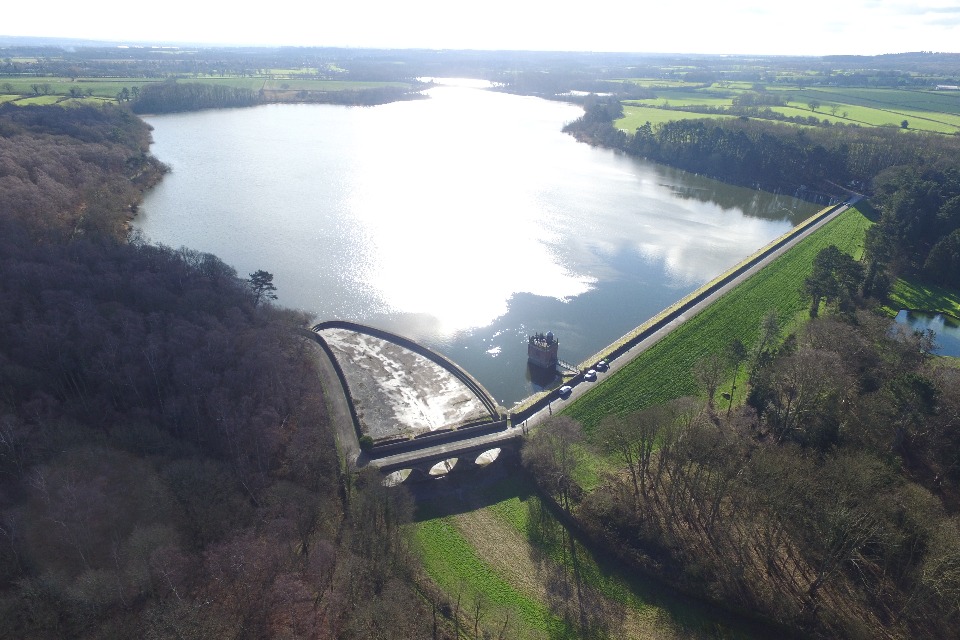
Photo 1 - aerial view of a typical impounding reservoir. Image reproduced with permission from Severn Trent Water.
A typical non-impounding reservoir is generally filled by piped inflow or pumped water into the reservoir. The embankment dam forms the entire edge of the reservoir. We use the term ‘inner face’ to describe the upstream side, and ‘outer face’ for the downstream side.
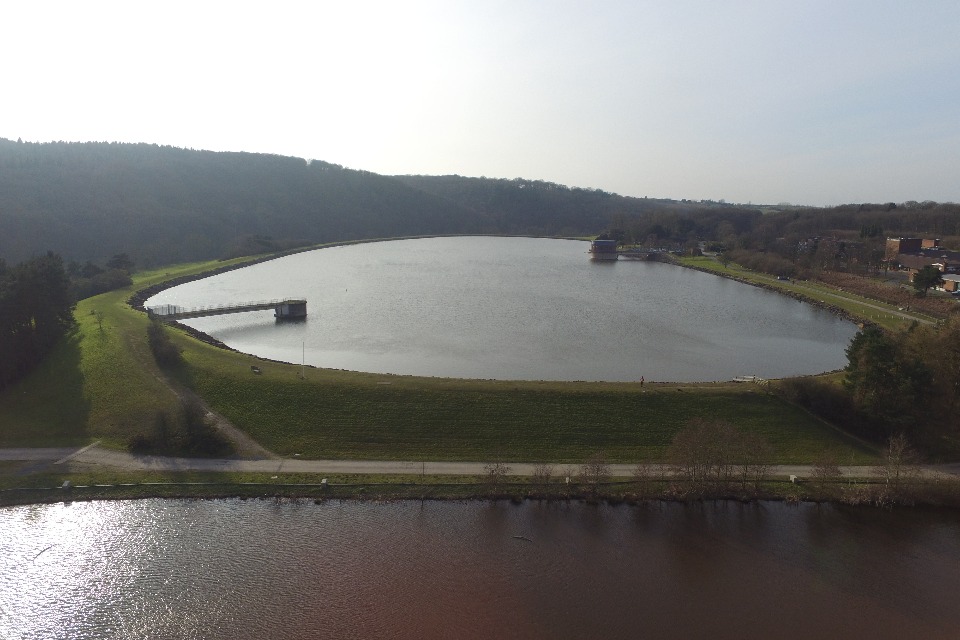
Photo 2 - a large raised non-impounding reservoir showing a circular grass embankment holding back water. Photo courtesy of Severn Trent Water.
The ‘spillway’ is the overflow that, in normal operation, allows water out of the reservoir in a controlled and safe way. This is like the overflow of a bathtub. It prevents the potentially dangerous effect of water flowing over the crest of the dam. The overflow is usually formed by a control weir and channel, although sometimes by pipes.
When the reservoir is full, most of the upstream face is underwater. The downstream face is the side of the embankment normally exposed. This is where you may first spot any problems.
There are 4 typical configurations of earth embankments, each with different ways to make them waterproof.
These are:
- solid clay embankment
- clay core embankment
- waterproof upstream face
- masonry or concrete dams
Solid clay embankment
A solid clay embankment is where the whole bank is made of the same (homogeneous) clay material. This is compacted to form a watertight barrier.

Diagram 3 - cross section of a reservoir bank made from compacted clay.
Clay core embankment
Clay core embankments have a central impermeable zone made of compacted clay, supported by ‘flanks’ or ‘shoulders’ of earth either side of the core.
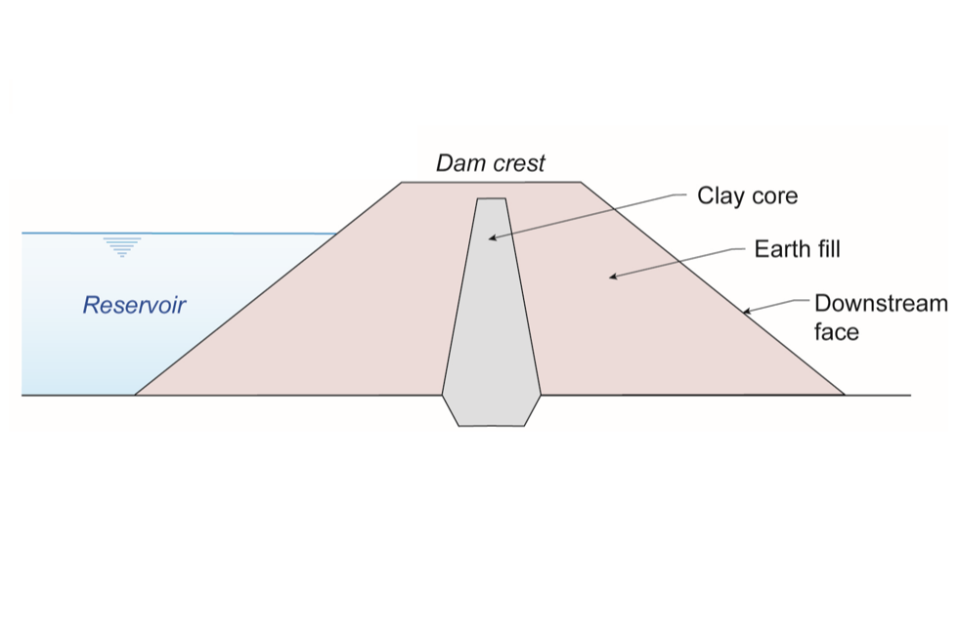
Diagram 4 - cross section of a reservoir bank made of earth fill, with a solid clay core in the middle which creates an impermeable layer.
Waterproof upstream face
A waterproof and impermeable liner can be placed on the upstream face of an earth embankment. This is usually made of plastic. It must be properly secured to the bank to stop it moving or coming loose.
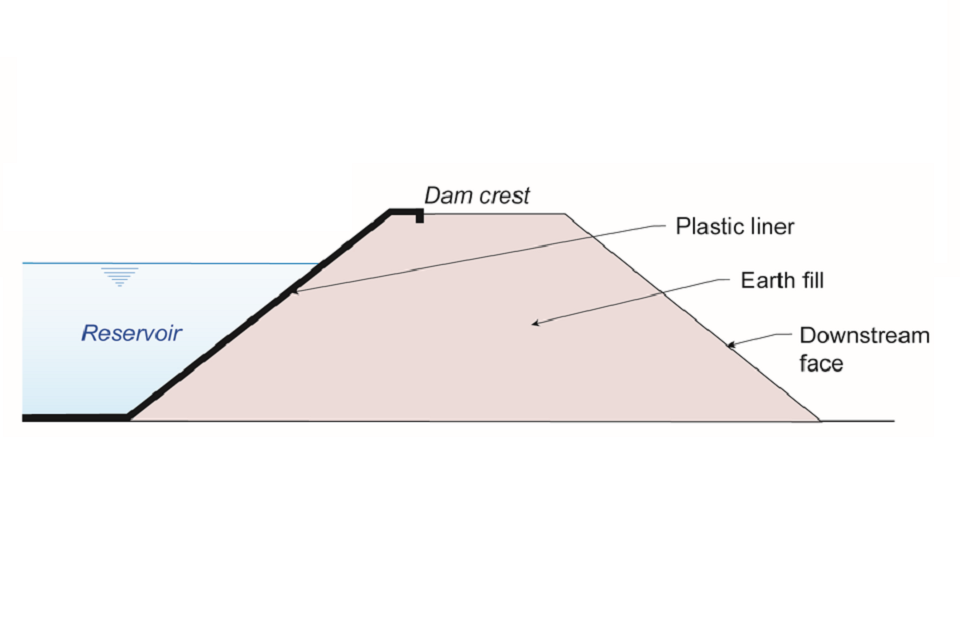
Diagram 5 - a cross section of a reservoir embankment with a homogeneous earth fill bank and a plastic liner on the upstream face, creating an impermeable layer.
Masonry or concrete dams
Masonry or concrete dams are much less common in England. Some are impounding. They can also be completely enclosed, containing treated drinking water. These are called service reservoirs and are normally owned by water companies.
You can read more about types of dams and the different terms used in About Dams on the British Dam Society website.
Reservoir Failure
What reservoir failure is
A reservoir failure is an uncontrolled release of water from the reservoir.

Photo 3 - a major failure of an earth embankment in 1992. Photo courtesy of D. Archer (Tyne and Tide: A celebration of the River Tyne, Daryan Press, 2003)
Why embankments fail
The 2 most common ways that embankment dams fail are:
- overflowing
- internal erosion
Overflowing
Overflowing of the dam crest happens when the spillway overflow is too small or becomes blocked. Normally, there is storage for a certain amount of excess water above the overflow level. If the amount of water coming in is greater than this capacity, flood water may start to overflow the dam crest.
When water overflows the reservoir it will run down the downstream face. If the flow is too large, or it lasts too long, the water will start to erode the surface of the embankment. It may erode so much that there is not enough support to hold back the water, and the reservoir will fail.
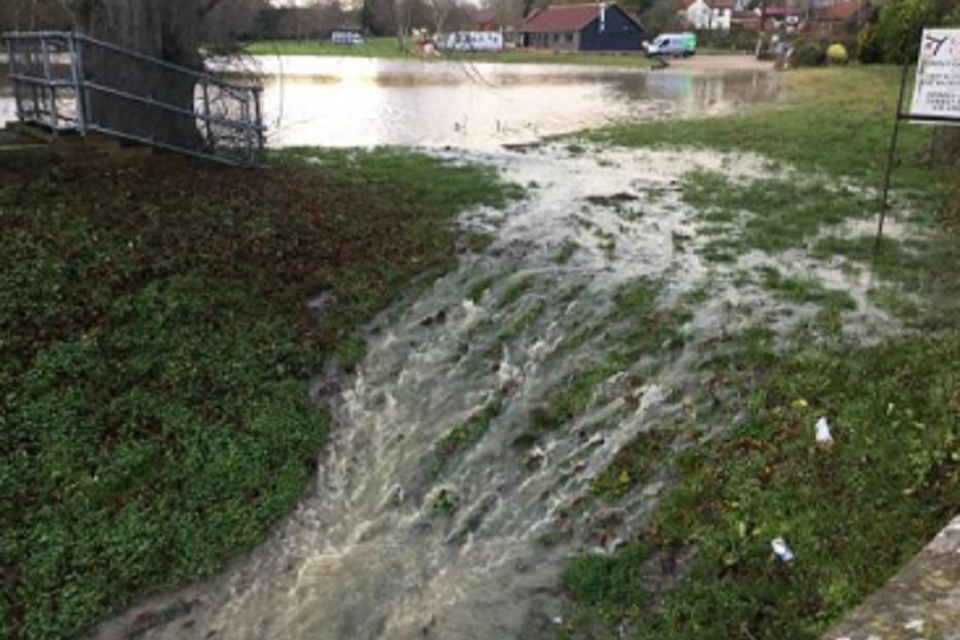
Photo 4 - an overflowing event at a reservoir. Photo courtesy of the Environment Agency.
Internal erosion
This happens when the pressure of the water in the reservoir manages to create a seepage path through the embankment. It then erodes from within.
This could be due to:
- poor construction of a clay core, embankment or plastic liner
- tree roots or vegetation growing though the embankment
- animals burrowing into the embankment
When internal erosion occurs, it will leave voids or holes within the dam. These can weaken the embankment. When this happens, the water may burst through.
The embankment may also sink down to fill these voids, which is called settlement. This can lower the crest height and leave it vulnerable to overflowing.
A common sign of seepage or leakage is patches of reeds appearing, or muddy puddles on the downstream face or toe.
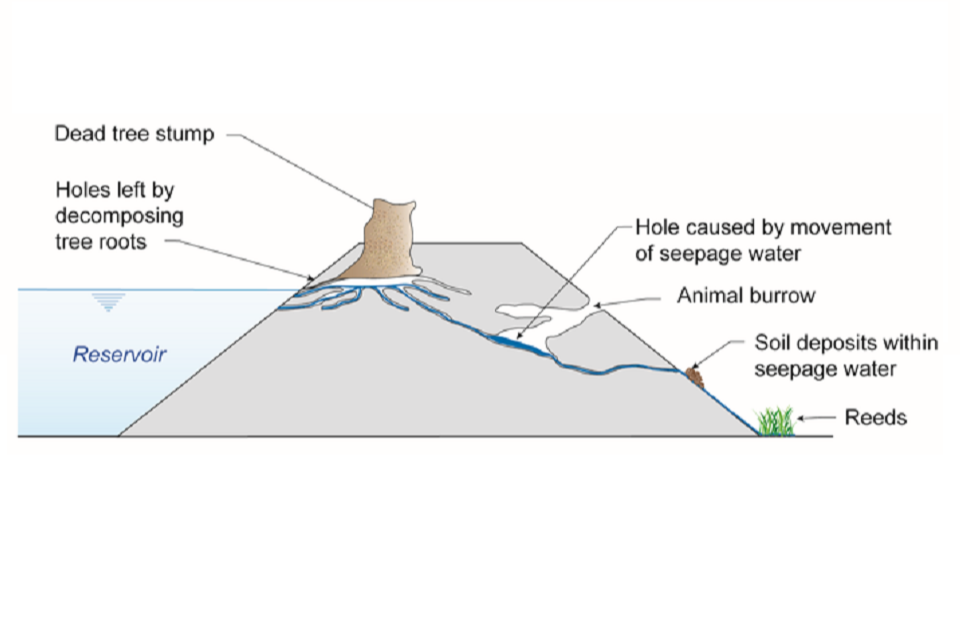
Diagram 6 - a cross section of a reservoir embankment with damage caused by trees and animal burrows. Soil deposition and reeds suggest seepage through the bank.
Checking your reservoir
You should walk around your site regularly to inspect your reservoir. This section highlights where to look, what to look out for and why.
If you see anything that worries you then seek professional advice from your supervising engineer.
Where to inspect your dam
You should check the:
- upstream face
- trash screens
- dam crest
- spillway
- downstream face
- valves and pipes

Photo 5 - a large reservoir with arrows labelling the main areas to inspect. Photo courtesy of Severn Trent Water.
Upstream face
You should check for:
- erosion by waves
- erosion by fisherman/ recreational users or animals
You should do this because erosion can weaken the dam
If you spot signs of erosion you should seek professional advice.
You could call or send some photos to your supervising engineer. The upstream face may need protection, which a qualified civil engineer will advise you on.

Photo 6 - an example of upstream face erosion as a result of fishing and recreational use. Photo courtesy of the Environment Agency.
Trash screens
You should check for blockages by vegetation and debris
You should do this because blocked spillways and pipes can lead to overflowing during flooding.
If you find blockages you should seek professional advice from your supervising engineer.
It is likely that you will need to clear the screens. You may be able to do this safely by using a long-handled rake from a position on the dam crest.
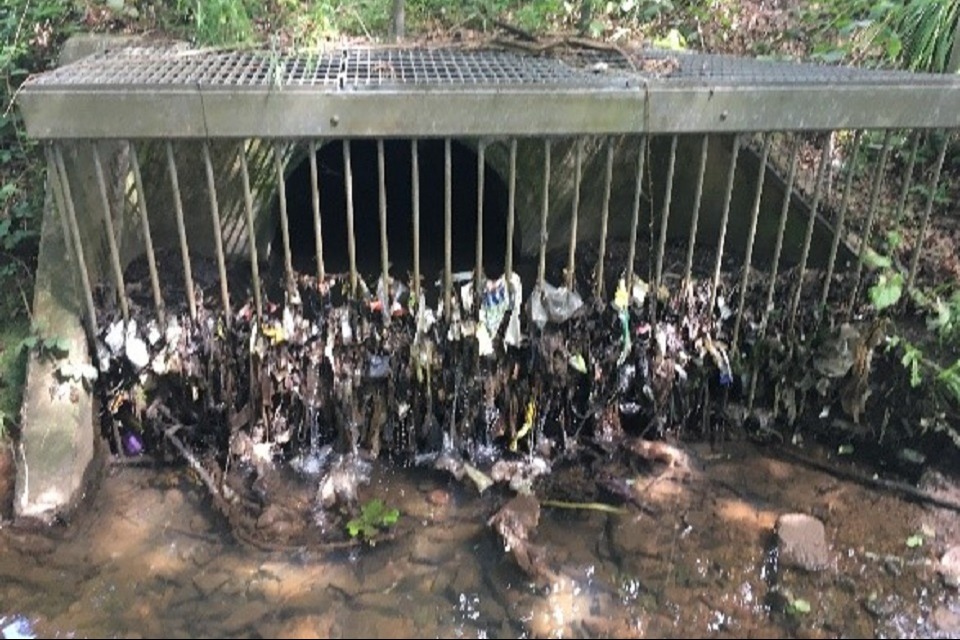
Photo 7 - a trash screen blocked with leaves and urban debris. Photo courtesy of the Environment Agency.
Dam crest
You should check for:
- sink holes
- cracks
- low spots
- changes in the appearance of fencing or on the ground, which may suggest ground movement
You should do this because sink holes and low spots may mean there is internal erosion below.
Cracks can allow rainwater into the body of the dam or indicate the start of a slip. These areas may concentrate flow when overflowing and contribute to erosion or failure.
If you see anything that worries you then seek professional advice from your supervising engineer.
You should try to avoid driving vehicles on the dam crest (unless there is a surfaced roadway). This can cause rutting and erosion.
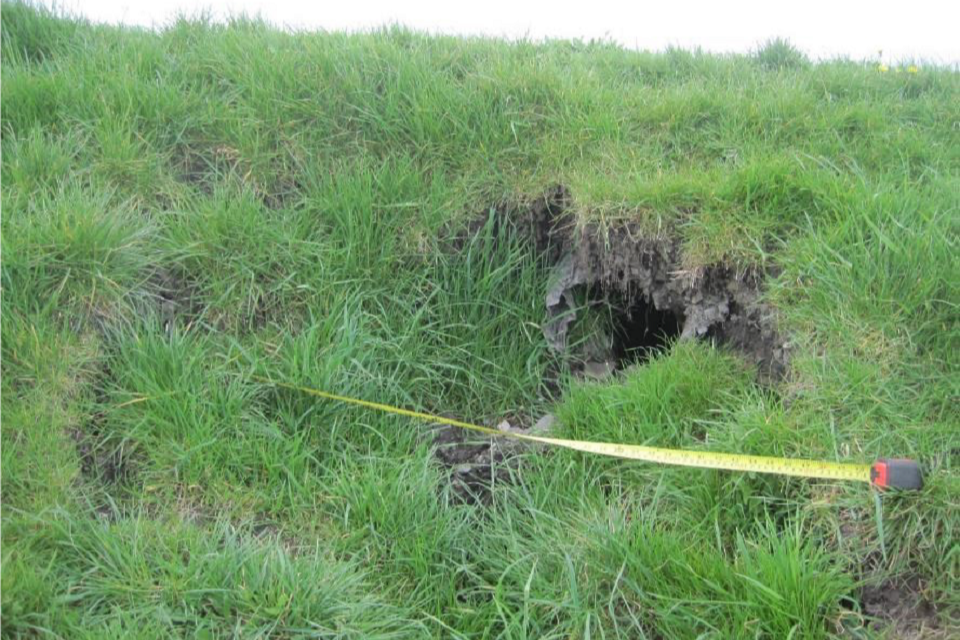
Photo 8 - animal burrows in an embankment. Photo courtesy of D. Brown.
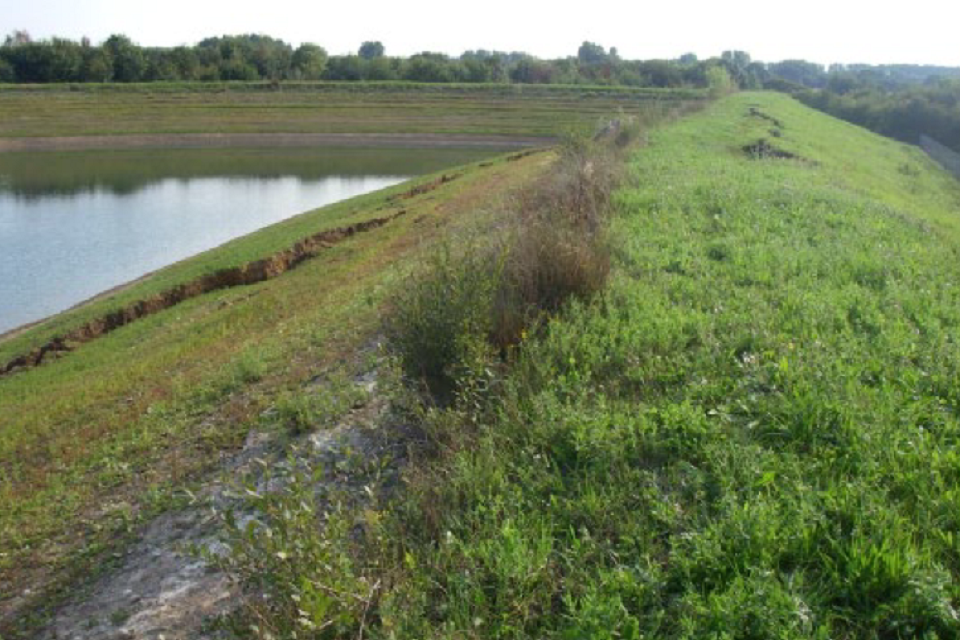
Photo 9 - cracks and movement of the crest and upstream face of a dam. Photo courtesy of the Environment Agency.
Spillway weir or overflow
What to look for depends on the type of spillway.
If you have a masonry or concrete spillway you should check for:
- debris or vegetation growing
- cracks in masonry
- missing pointing or sealant
- changes in the condition of any structures
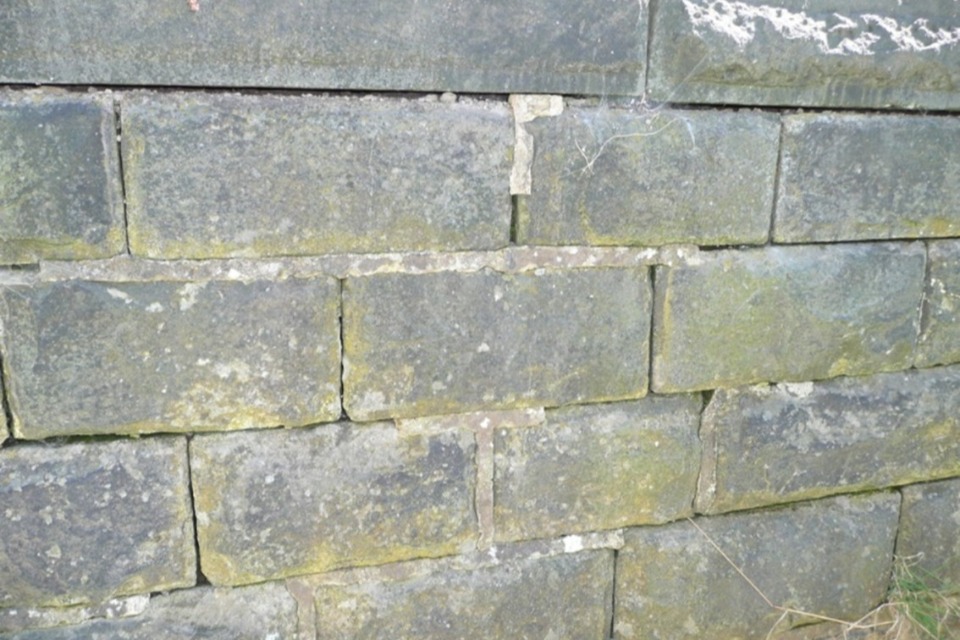
Photo 10 - cracks and missing pointing in masonry wall. Photo courtesy of P. Mason.
If you have an earth spillway you should check for:
- cracks
- ruts
- animal damage
- evidence of slips
You should do this because blocked spillways can lead to dam crest overflowing. Damaged spillways increase the risk of failure when water is overflowing.
You should clear any blockages you find if it is safe to. Otherwise, arrange a professional to do this. Cut back and prevent vegetation from growing on the spillway. If you spot anything that worries you, seek professional advice from your supervising engineer.
Downstream face
You should check for:
- wet patches, particularly if the water is muddy
- growth of reeds
- slips
- cracks
- animal burrows
You should do this because any of these issues can indicate stability or internal erosion problems. These could lead to dam failure.
You should limit vegetation to short grass if possible. Check any mature trees on the downstream face are healthy and stable.
Monitor any changes and if you spot anything, seek professional advice from your supervising engineer.

Photo 11 - wet patches on downstream face of embankment dam. Photo courtesy of D. Brown.
Valves and pipes
You should check for:
- signs of leakage
- rust on moving parts
- damage
You should do this because leaks can lead to erosion and inoperable valves make responding to an incident difficult.
It may mean expensive pumps will be needed to on site to draw down the water.
You should regularly operate your valves to make sure they are working as they should be. This can help stop them from seizing up. If doing this will discharge water to a downstream watercourse and cause potential environmental damage, you may need approval from the Environment Agency. Contact us to check if this is the case.
If you spot any damage, leakage or your valves are not working; seek professional advice from your supervising engineer.
How monitoring can help
Finding any of these problems does not always mean you need urgent and expensive repair work.
Monitoring over time can help you find out the cause. Sometimes it is from rainfall and groundwater and not a problem with the reservoir.
Always seek professional advice when you spot a new problem, particularly if you can see it is getting worse.
How often should I visit?
You should visit your reservoir at least once a month. Most will need this more often. For example, if your spillway or trash screens are in a wooded area, they may need clearing multiple times a week. A qualified civil engineer will advise you on what you need to do.
You should inspect your reservoir often enough to carry out regular maintenance and monitoring. This allows you to spot any changes or potential problems early. This can save a lot of money though early management of risks.
Typical maintenance tasks and why they are important
Trees, vegetation and grass cover
The ideal dam has a healthy, short (50 to 150 mm) covering of grass on its crest and downstream face. There should be no trees or other vegetation. This allows you to spot problems early before they become difficult and expensive to fix.
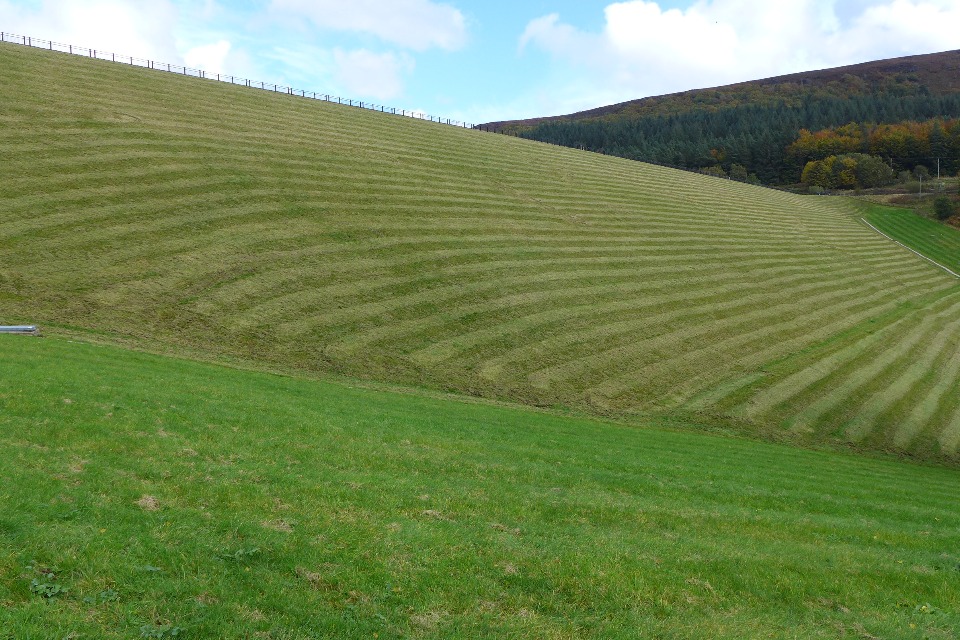
Photo 12 - an example of the downstream face of a reservoir in good condition. Photo courtesy of Severn Trent Water.
Vegetation can cause water to form concentrated flow paths, which speeds up erosion.
Trees are a big problem on dams. This is because:
- they can blow over in storms - this tears holes in the banks which may become unstable and cause more erosion to occur
- roots can puncture waterproof liners, leading to internal erosion
- roots can damage structures, increasing risk of erosion and failure
- dead roots can leave holes, which act as seepage paths and speed up internal erosion
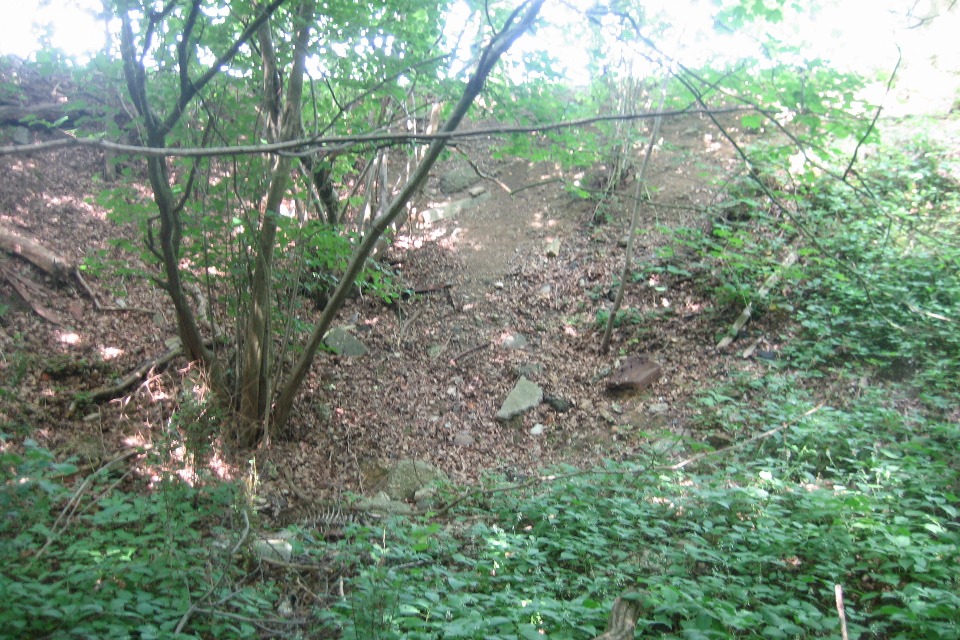
Photo 13 - a downstream face with vegetation, bare earth and debris. Photo courtesy of C. Goff.
This increases the risk of surface erosion during heavy rain. The trees will concentrate flow paths and make erosion worse.
You should:
- remove young trees before they become established
- monitor mature trees and keep the canopies high to allow light to reach the base for better grass growth
- get a tree surgeon to assess top heavy, dead or dying trees - you should seek advice from a qualified civil engineer if any need to be removed
Maintain clear spillways/pipes
Spillways, trash screens and pipe inlets can become blocked by debris, for example leaves, sticks and litter. This can cause the water level to rise and eventually overflow the dam.
You should:
- check trash screens regularly and clear away debris - always check the screens after heavy rainfall or windy days
- cut back reeds and other vegetation growing near to the spillway or inlet pipes - make sure you do not put yourself in danger when cleaning the spillway
Discourage animal activity
Burrowing animals make holes in embankments. This leads to settlement, sink holes or leakage paths. In severe cases, embankments full of badger setts, mole tunnels or rabbit warrens have collapsed.
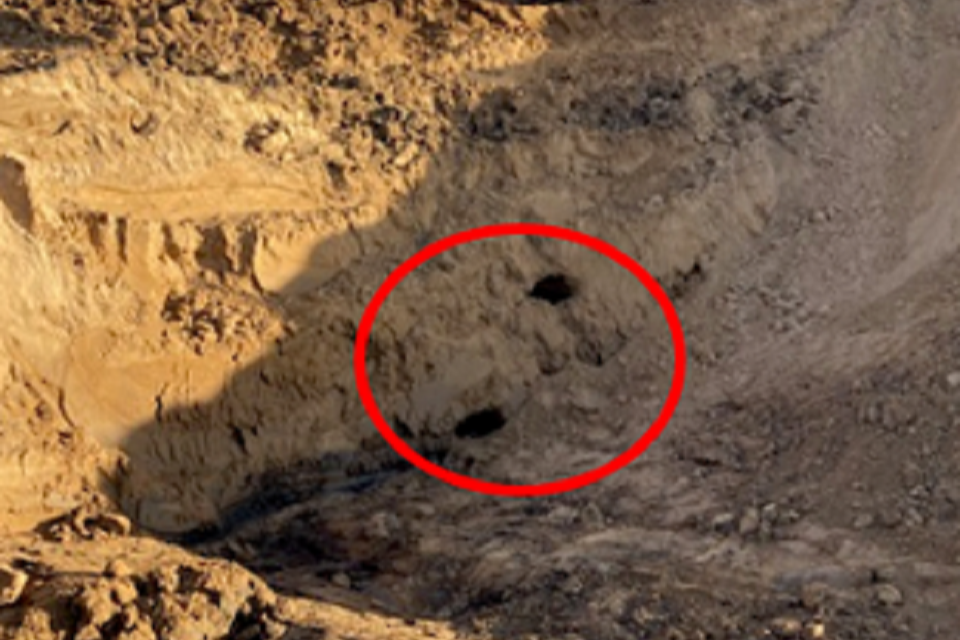
Photo 14 - badger tunnels visible when digger has removed a cross section of the embankment. Photo courtesy of the Environment Agency.
You should discourage animals from burrowing by:
- keeping grass short so the face is easy to inspect
- filling in animal burrows with compacted clay – provided this is not against the law
- humanely trapping or culling - provided this is not against the law
You must comply with wildlife legislation.
Contact the Environment Agency or Natural England if you are unsure what activities you can legally do. Always discuss with your supervising engineer before you do any work on the dam.
Check valves
If you spot a problem at your reservoir, your supervising engineer is likely to recommend lowering the water level.
The simplest way to do this is to open the bottom outlet valve if your reservoir has one.
If you have a bottom outlet valve (also referred to as a scour valve), you should keep it in good working order in case of emergency.
To do this, you should:
- protect the valve by using grease, paint or a galvanised coating
- keep the spindle (turning mechanism) greased
- fully open and close the valve at least twice a year to make sure it has not seized up – you should note this in your prescribed form of record as it maintains evidence of good maintenance measures.
- If doing this will discharge water to a downstream watercourse, you may need approval from the Environment Agency - contact us to check if this is the case
- have the valve inspected by your supervising engineer, who will advise on how to fix any problems
- keep a note of the direction and number of turns needed to open and close the valve
- keep the contact details of a 24-hour pump supplier in your onsite plan in case of emergency
If the valve stops working, or you do not have one, the only way to lower the reservoir will be by external pumps. If you need to do this, you should seek professional advice from your supervising engineer as it may cause downstream erosion. This can be an expensive solution.

Photo 15 - large pumps over an embankment. Photo courtesy of the Environment Agency.
What other legislation should I be aware of
It is important to remember that there are other laws which may impact what you can and cannot do when managing your reservoir.
Common examples are:
- Protection of Badgers Act 1992 – this makes it illegal to harm badgers or their setts
- Wildlife and Countryside Act 1981 – this makes it illegal to release crayfish into a watercourse, and to disturb or damage a bird’s nest
- Water Resources Act 1991 – this controls what water you can release into a water course
The Environment Agency or Natural England can help advise you if you think any activities you are planning may break the law.
You may need planning permission or an environmental permit. if you need to build or change part of your reservoir.
Asking for help
When I should ask for professional advice
Dam failures can kill, and all reservoir owners should take this risk very seriously. All dams are different. However, in general you should seek professional advice if:
- the dam crest is in danger of overtopping
- there is a sudden increase in seepage or leakage from the bottom of the bank
- seepage or leakage becomes muddy or cloudy
- there are signs of slips or cracks on the dam
- a low spot appears on the dam crest
- you spot anything unusual or feel uneasy about any aspect of your reservoir
A panel engineer and the Environment Agency can help advise on what you need to do.
How do I prepare for an emergency?
It is a legal requirement to prepare an emergency on-site plan for your reservoir. A panel engineer can help with this.
If your dam is in danger of collapse, you must contact:
- a panel engineer – always keep their contact details to hand
- the Environment Agency incident hotline, which is a 24-hour service
- the emergency services
They will help advise on an emergency drawdown and notify anyone living downstream.